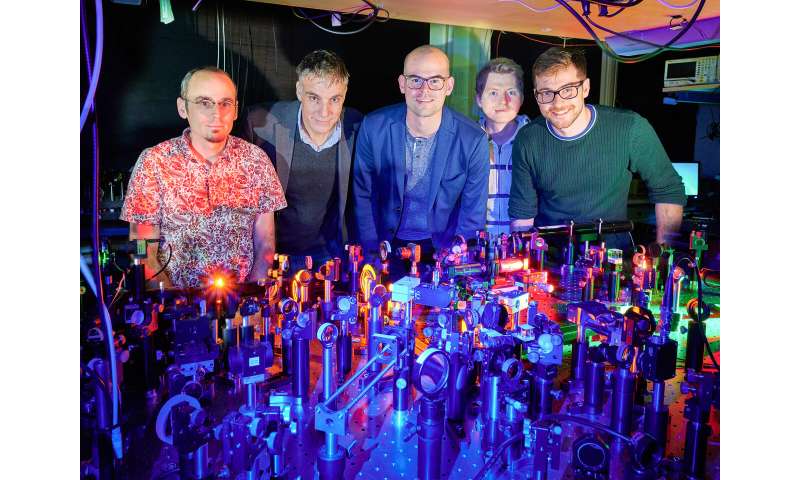
Light can be directed in different directions, usually also back the same way. Physicists from the University of Bonn and the University of Cologne have, however, succeeded in creating a new one-way street for light. They cool photons down to a Bose-Einstein condensate, which causes the light to collect in optical "valleys" from which it can no longer return. The findings from basic research could also be of interest for the quantum communication of the future. The results are published in Science.
A light beam is usually divided by being directed onto a partially reflecting mirror: Part of the light is then reflected back to create the mirror image. The rest passes through the mirror. "However, this process can be turned around if the experimental set-up is reversed," says Prof. Dr. Martin Weitz from the Institute of Applied Physics at the University of Bonn. If the reflected light and the part of the light passing through the mirror are sent in the opposite direction, the original light beam can be reconstructed.
The physicist investigates exotic optical quantum states of light. Together with his team and Prof. Dr. Achim Rosch from the Institute for Theoretical Physics at the University of Cologne, Weitz was looking for a new method to generate optical one-way streets by cooling the photons: As a result of the smaller energy of the photons, the light should collect in valleys and thereby be irreversibly divided. The physicists used a Bose-Einstein condensate made of photons for this purpose, which Weitz first achieved in 2010, becoming the first to create such a "super-photon."
A beam of light is thrown back and forth between two mirrors. During this process, the photons collide with dye molecules located between the reflecting surfaces. The dye molecules "swallow" the photons and then spit them out again. "The photons acquire the temperature of the dye solution," says Weitz. "In the course of this, they cool down to room temperature without getting lost."
By irradiating the dye solution with a laser, the physicists increase the number of photons between the mirrors. The strong concentration of the light particles combined with simultaneous cooling causes the individual photons to fuse to form a "super-photon," also known as Bose-Einstein condensate.
Two optical valleys "catch" the light
The current experiment worked in accordance with this principle. However, one of the two mirrors was not completely flat, but had two small optical valleys. When the light beam enters one of the indents, the distance, and therefore the wavelength, becomes slightly longer. The photons then have a lower energy. These light particles are "cooled" by the dye molecules and then pass into a low-energy state in the valleys.
However, the photons in the indents do not behave like marbles rolling over a corrugated sheet. Marbles roll into the valleys of the corrugated sheet and remain there, separated by the "peaks."
"In our experiment, the two valleys are so close together that a tunnel coupling occurs," reports lead author Christian Kurtscheid from the Weitz team. It is therefore no longer possible to determine which photons are in which valley. "The photons are held in the two valleys and enter the lowest energy state of the system," explains Weitz. "This irreversibly splits the light as if it were passing through an intersection at the end of a one-way street, while the light waves remain in lockstep in different indents."
The scientists hope that this experimental arrangement will make it possible to produce even more complex quantum states that allow the generation of interlaced photonic multi-particle states. "Perhaps quantum computers might one day use this method to communicate with each other and form a kind of quantum Internet," says Weitz with a view towards the future.
Explore further
Citation: Physicists irreversibly split photons by freezing them in a Bose-Einstein condensate (2019, November 14) retrieved 14 November 2019 from https://phys.org/news/2019-11-physicists-irreversibly-photons-bose-einstein-condensate.html
This document is subject to copyright. Apart from any fair dealing for the purpose of private study or research, no part may be reproduced without the written permission. The content is provided for information purposes only.
Bagikan Berita Ini
















0 Response to "Physicists irreversibly split photons by freezing them in a Bose-Einstein condensate - Phys.org"
Post a Comment